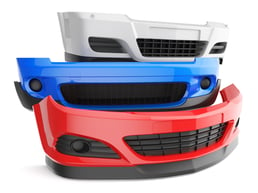
In our most recent post in the “Learn More About your Plastic Sheet” blog series we featured our extruded HIPS material and highlighted some of the characteristics and attributes of the material. Today, we will switch gears to a polymer that services a more industrial market where material durability for long-term use is paramount - TPO, or thermoplastic polyolefin. TPO is a combination of polymer and filler blends usually consisting of some fraction of a thermoplastic (generally block copolymer polypropylene), an elastomer or rubber—often ethylene propylene rubber to enhance durability—and fillers such as calcium carbonate or talc. These fillers are added to modify the physical properties of TPO. Compared to polyethylene, TPO offers improved chemical and moisture resistance, making it more suitable for demanding industrial and roofing applications.
To learn more about TPO’s characteristics and typical uses continue reading!
-
TPO is widely used in the automotive market:
As the capabilities of TPO grow, the applications it is used in have followed suit. TPO has been widely adapted for use in both exterior and interior automotive applications, replacing more traditional materials such as metal and other engineering thermoplastics. The driving force behind this material switch is to reduce the weight of the automobile.
However, aesthetics continue to remain a high priority for automotive applications, which has in turn led to polymer enhancements in order satisfy the requirement for a Class A surface. To satisfy this requirement resin companies have created polymer grades with an enhanced aesthetic appeal:
“Exxon Chemical, Co., Houston, reported that modifying TPOs with metallocene-based plastomers instead of conventional rubbers does more than improve low-temperature impact and flowability: Plastomers may also improve paint adhesion. Exxon offers a new commercial grade of plastomer-modified TPO aimed at fascias.” (Source: Plastics Technology)
Now with new polymer innovations, consumers in the automotive industry can take advantage of the properties of this polymer without sacrificing aesthetic appeal. 2. TPO is UV stabilized:
TPO needs to endure anything Mother Nature throws at it - and at the top of this list is exposure to UV light. Today there are many grades of TPO available that provide this UV protection. Grades such as MetaForm 7200 by Mytex Polymers have special additive packages that prevent custom colors from fading due to sun exposure over an extended period of time. These advancements in polymer technology make TPO the unrivaled solution for outdoor parts. In addition to the UV Stabilized grades, additive packages that can be added during extrusion are also available to further enhance the longevity the material. TPO is highly resistant to UV rays, making it an excellent choice for outdoor and roofing applications. 3. TPO has great impact strength and temperature resistance:
Enough about the aesthetics of TPO - now lets get down to the nitty-gritty and the sole reason why TPO is the best material for markets that require durability. TPO is designed to provide the optimum balance of stiffness, cold temperature impact, and low thermal expansion. It is ideal for applications where weatherability and durability to all conditions is crucial. These qualities are perhaps the leading reason why this polymer has found a home in Automotive and Industrial markets. TPO is also a flexible material, allowing it to be used in a wide range of consumer and industrial applications.
In both of these markets, the finished part will have exposure to heat and cold, and will need to keep its shape while allowing for limited thermal expansion or contraction. Imagine if on a hot summer day the bumper on car started to expand and cracked! That would be completely unacceptable! So as automotive companies began to shift from traditional metal materials to materials like TPO, avoiding problems like this was at the top of their list of requirements when qualifying replacement materials.
To give you an idea if TPO can actually compete with metals in terms of durability this test by Ford should give you confidence:
“Ford’s stringent low-temperature impact specification requires that the pillar will not crack when a 10-lb ball is dropped on it from 6 ft at -30 C.” (Source: Plastics Technology)
-
TPO can be colored during extrusion:
As mentioned, TPO is designed to withstand harsh conditions while maintaining performance. While these conditions may expose the material to wear and tear, aesthetics, such as custom colors are still a priority. During the extrusion process TPO can be colored to any custom color of your choosing. Whether you have a color target you’d like matched, or a PMS color, one of our partnered color suppliers will exceed expectations for any market. 5. TPO is flame retardant:
Because of the two largest applications TPO services (automotive and roofing), it is essential for this material to be flame retardant. Although this polymer is not as inherently fire-resistant as competing materials, this can be modified by adding fire retardant chemicals and additives during the compounding process. 6. Is TPO an amorphous or a crystalline polymer?
You would think this would be a simple answer but it isn’t. Because TPO is an olefin compounded with rubber this question becomes difficult and the answer depend on a variety of factors, like the content of rubber for example:
“If PP and PE are the dominant component of a TPO blend then the rubber fraction will be dispersed into a continuous matrix of “crystalline” polypropylene. However, if the fraction of rubber is greater than 40% phase inversion may be possible when the blend cools, resulting in an amorphous continuous phase, and a crystalline dispersed phase.” (Source: Thermoplastic Olefin, Wikipedia)
-
TPO is recyclable:
TPO is a 100% recyclable material, but due to the nature of the material, and the long life cycle applications that it typically is used in, the recycling stream is not as strong as it should be. However, certain markets seem to be discovering a way to recycle and repurpose this material while saving money along the way. Some engineered TPO products are designed to degrade under specific conditions, but most TPO is not biodegradable and should be properly recycled to minimize environmental impact.
In the last few years, many TPO manufacturers have started programs to educate both roofing contractors and building owners about the benefits and the process of TPO recycling. Recycling TPO not only benefits the environment by reducing our carbon footprint, it also offers financial incentives
TPO is commonly manufactured as membranes and is a leading single ply roofing membrane for commercial and industrial buildings. TPO membranes are composed of multiple plys, including a reinforced scrim and a weather-resistant outer layer, which help protect against weathering and environmental damage. TPO roofs are especially popular for flat roofs due to their highly reflective surfaces, which can significantly reduce cooling costs. When compared to other roofing materials like EPDM and PVC, TPO offers advantages in energy efficiency, weather resistance, and cost-effectiveness. Insulation is a critical component in TPO roofing systems, with expanded polystyrene and extruded polystyrene being common choices beneath the membrane. A cover board is often installed above the insulation to provide a supportive substrate for the TPO membrane.
TPO membranes can be installed using various methods, including bonding adhesive, adhesive, or by welding the seams for a watertight seal. It is important to have TPO roofing properly installed by professionals, as installation costs can vary depending on factors such as roof size, removal of old materials, and added insulation. Periodic repair and maintenance are necessary, including checking flashings, addressing wet insulation, and keeping the membrane free from dirt and debris. The cost of TPO roofing is often calculated per square foot, and overall roofing costs can be offset by the energy savings from the membrane’s highly reflective properties. An infrared camera is often used to inspect TPO roofs for moisture or insulation issues, helping to identify areas that may require repair or replacement.
We hope this insight has taught you something new about what TPO is capable of and why it offers a great solution for the markets it services. For more information on our TPO products, download our TPO material solutions today!





